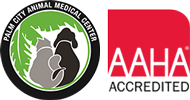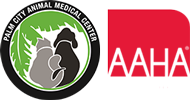Over half of U.S. pets are overweight, making obesity the most commonly diagnosed pet disease nationwide. Following that trend is an increase in weight-related health conditions, and a decrease in life expectancy of nearly two-and-a-half years. Unfortunately, some pet owners find visible weight changes hard to detect, which delays diagnosis and treatment until the pet is significantly overweight.
Reduced activity can be a more easily noticed sign that something is amiss with your pet’s health. Before dismissing suddenly sedentary behavior as “old age,” feel your pet’s ribs and waistline—you may be surprised to find there’s more to love than you remember. If so, it’s time to schedule a weight-loss consultation at Palm City Animal Medical Center, and to get your pet back on their paws.
Pet obesity’s impact on overall health
In addition to altering your pet’s quality of life by affecting their mobility, excess fat (i.e., adipose) tissue releases pro-inflammatory hormones and cells. Persistent or chronic inflammation in the body increases your pet’s risk for many debilitating conditions, including:
- Certain cancers
- Arthritis
- Kidney dysfunction
- Orthopedic disease (e.g., cranial cruciate or ACL tear)
- Endocrine disorders (e.g., diabetes)
- Respiratory disease
- Skin disorders
- Heart conditions
These issues and others can result in much higher veterinary costs for overweight pets. When treatment becomes cost-prohibitive, or the disease progresses beyond medical management, many pets are euthanized.
Schedule a pre-exercise physical examination for your pet
Eating less and exercising more is not necessarily a wise choice for your overweight pet—at least, not without veterinary supervision. Suddenly reducing or changing your pet’s food can cause malnutrition, while inappropriately exercising your pet may result in pain, orthopedic injury, heatstroke, or exhaustion.
Before making any changes, bring your pet to Palm City Animal Medical Center for an examination and lab work. Weight gain can be caused by endocrine disorders, such as underactive thyroid, overactive adrenal glands, parasites, or fluid accumulation. If we diagnose a problem, treatment may be all that is necessary to help your pet lose weight. If your overweight pet is otherwise healthy, we’ll use their body condition score, current food and treats, and lifestyle, to make customized recommendations for diet, safe exercise, and weight-loss goals.
Get going! Exercising your overweight pet

Once your pet is cleared for exercise, and their nutrition plan is in place, they need to get moving. Forget the same old boring walk or feather wand—here are our favorite ways to safely boost your pet’s physical activity:
- Physical therapy and rehabilitation services — Low-impact exercise is key to restoring overweight pets to their former physical abilities. Palm City Animal Medical Center can design a customized workout plan for your pet that burns calories, while building strength, balance, and flexibility, and may include:
-
- Hydrotherapy — Our underwater treadmill provides a full-body and cardiovascular workout experience, without the physical demands of gravity on a pet’s aching joints.
- Therapeutic exercises — Our range of inflatable balance discs, balls, and unstable surfaces will challenge your pet’s balance, engage their core muscles, and build physical strength and confidence.
- Swimming — Dogs who refuse to walk may prefer swimming. Introduce your pet gradually, to build their confidence, ensure they wear a life-jacket, and keep sessions short. Swimming is tiring, especially for out-of-shape pets.
- Walking and hiking — If your pet is uninspired by their neighborhood, take them to a new park. Unusual sights and smells should motivate them to move.
- Play in the environment — Challenge your pet along the route. For example, put their front feet up on a rock or tree stump, or have them step over low-height sticks, circle around a tree, dig, or walk across a creek bed.
- Cat environmental enrichment — Give your indoor cat things to investigate, such as stacked cardboard boxes or Catty Stacks, play tunnels, ramps, and multi-tier cat trees. Create window perches with safe up-and-down access, so your cat doesn’t have to jump.
- Interactive toys — Animated toys that behave like prey can be extremely motivating for cats. Ensure you put the toy away at the end of each play session, to maintain its novelty. Dogs may enjoy playing with a flirt pole, which looks like a giant cat feather wand.
- Food foraging —Obese pets tend to eat quickly, and feel hungry soon after. Activities that require your dog or cat to seek out their food promotes physical activity, and slows the eating and digestion process, making them feel full sooner.
- Food puzzles for dogs and cats
- Snuffle mats
- Scatter dry food in untreated grass
- Hide food in small bowls or Kongs in one room
- Learning new things — Motivate your dog to move by trying a fun new activity. The following sports are so much fun for dogs, they won’t know they’re working out!
- Nosework — Your dog learns to search for a hidden odor, such as birch or clove.
- Trick training — Tricks improve pet confidence and body awareness.
- Treibball — In this urban version of herding, dogs push large exercise balls toward a goal, under their handler’s direction.
Don’t be discouraged if your pet shows no interest in your early exercise attempts—simply select another activity, and try again. Additionally, do not feel frustrated if your pet can be active only for a few minutes. Building stamina is a gradual process, and rushing too quickly may cause physical harm, or discourage your pet. Find small ways to encourage more motion every day—every step is one step closer to a longer life.
To schedule your pet’s weight-loss consultation, contact Palm City Animal Medical Center.








Leave A Comment